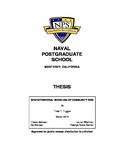Spatiotemporal modeling of community risk
| dc.contributor.advisor | Wollman, Lauren | |
| dc.contributor.advisor | Nieto-Gomez, Rodrigo | |
| dc.contributor.author | Tuggle, Todd T. | |
| dc.date | Mar-16 | |
| dc.date.accessioned | 2016-04-29T21:19:05Z | |
| dc.date.available | 2016-04-29T21:19:05Z | |
| dc.date.issued | 2016-03 | |
| dc.identifier.uri | https://hdl.handle.net/10945/48484 | |
| dc.description.abstract | Every day throughout the country, fire departments respond to a variety of emergencies in their communities. Steadily over the last decade, departments have mitigated these threats in an atmosphere of decreasing budgets, declining fire volume, and a burgeoning call volume. Thus, fire service leaders require data and analysis to justify the dollars spent to mitigate the risks within communities. Community risk is dynamic in that it fluctuates over geography and time; spatiotemporal modeling is one proven method for illustrating such dynamic modulations. This thesis produces a spatiotemporal model of fire department call volume to depict fluctuations in community risk in the Fresno (CA) Fire Department’s area of operations. This study led to several findings. First, using historical records for spatiotemporal modeling of community risk could help leaders visualize the dynamic nature of risk. Second, visualizing community risk with spatiotemporal modeling could provide the basis for resource deployment models attuned to specific risks. Finally, investigating additional data sets in conjunction with such methodology could uncover the causal factors of risk dynamics from which leaders design proactive preventative measures. | en_US |
| dc.description.uri | http://archive.org/details/spatiotemporalmo1094548484 | |
| dc.publisher | Monterey, California: Naval Postgraduate School | en_US |
| dc.rights | Copyright is reserved by the copyright owner. | en_US |
| dc.title | Spatiotemporal modeling of community risk | en_US |
| dc.type | Thesis | en_US |
| dc.contributor.department | National Security Affairs | |
| dc.contributor.department | National Security Affairs | en_US |
| dc.subject.author | GIS | en_US |
| dc.subject.author | geospatial information systems | en_US |
| dc.subject.author | fire service | en_US |
| dc.subject.author | fire department | en_US |
| dc.subject.author | community risk | en_US |
| dc.subject.author | spatiotemporal | en_US |
| dc.subject.author | spatial | en_US |
| dc.subject.author | temporal | en_US |
| dc.subject.author | quantitative analysis | en_US |
| dc.subject.author | deployment model | en_US |
| dc.description.service | Battalion Chief, Fresno Fire Department, California | en_US |
| etd.thesisdegree.name | Master of Arts in Security Studies (Homeland Security and Defense) | en_US |
| etd.thesisdegree.level | Masters | en_US |
| etd.thesisdegree.discipline | Security Studies (Homeland Security and Defense) | en_US |
| etd.thesisdegree.grantor | Naval Postgraduate School | en_US |
| dc.description.distributionstatement | Approved for public release; distribution is unlimited. |
Files in this item
This item appears in the following Collection(s)
-
1. Thesis and Dissertation Collection, all items
Publicly releasable NPS Theses, Dissertations, MBA Professional Reports, Joint Applied Projects, Systems Engineering Project Reports and other NPS degree-earning written works.





